A Magnetic Hose
July 7, 2014
electricity and
magnetism have a lot in common. The first clue is that they share one of the
four fundamental forces, called
electromagnetism, the others being
gravitation, the
strong nuclear force, and the
weak nuclear force. You can have
electric dipoles producing
electric fields in
space, and
magnetic dipoles producing
magnetic fields in space.
One small failure of this
analogy is that you can have
electric charge and
electric monopoles, but we haven't discovered the equivalent
magnetic charge and
magnetic monopole. This isn't for lack of trying, since there a quite a few reasons why
physicists believe that they should exist.[1]
Just as we have
wires conducting electricity in
electrical circuits, we also have
magnetic materials conducting magnetism in
magnetic circuits. There are many
useful analogies between these two types of circuits, such as those between
electromotive force and
magnetomotive force;
electric current and
magnetic flux; and
electrical resistance and
magnetic reluctance.
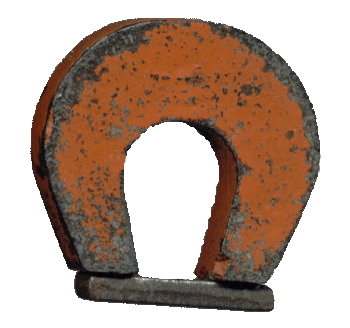
One common magnetic circuit is the one made by a horseshoe magnet and its "keeper."
The keeper ensures that the magnetic field is mostly contained in the magnetic. This reduces the tendency for such magnets to demagnetize.
(Photograph by Eurico Zimbres FGEL/UERJ, via Wikimedia Commons.)
The analogy is not perfect, since electric charges flow in electrical circuits, but there's nothing flowing in a magnetic circuit. Also, magnetic conductors, which are magnetic materials, are less perfect in conducting magnetic fields than wires are at conducting electricity. While there's a large difference between
electrical conductance in a
vacuum and in a wire, magnetic conductance in a magnetic material is only a few hundred to a few thousand times greater than that in a vacuum (a.k.a., "
free space"). In a word, magnetic circuits leak.
Analogies are such a useful
pedagogical construct that electricity, itself, has an
analogy based on hydraulics. This analogy was invented by
Oliver Lodge, who was famous for his many contributions to early
radio research. The analogy persists to the present. My
father often referred to electricity as "juice," which, to my younger mind, meant that the
transformers mounted on
utility poles were juice
storage containers.
It's easy to think of a wire as a
hose that carries electricity. This leads to the idea of a "magnetic hose." Just as an "electrical hose" will
translate an electrical field from one place to another, a magnetic hose will do the same for a magnetic field. An international team of
scientists from the
Universitat Autònoma de Barcelona (Barcelona, Spain), the
Austrian Academy of Sciences (Innsbruck, Austria), the
University of Innsbruck (Innsbruck, Austria), and the
Max-Planck-Institut für Quantenoptik (Garching, Germany), has demonstrated such a hose by combining magnetic and
superconducting materials.[2-5]
A
superconductor, in this case the
high temperature superconductor,
yttrium barium copper oxide (YBCO), is used as a means of preventing the magnetic fields inside a
ferromagnetic iron alloy from leaking out into free space. The principle behind this is the
Meissner effect, discovered in 1933 by the
German physicists,
Walther Meissner and
Robert Ochsenfeld, quite a few years after the
discovery of superconductivity by
Heike Kamerlingh Onnes. The delay, of course, was because of the difficulty of doing
experiments at
cryogenic temperatures.
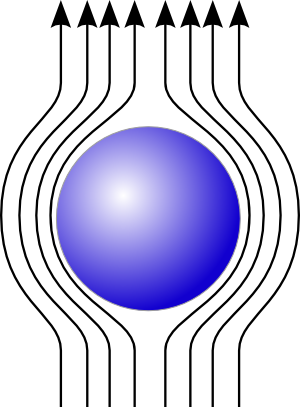
In the Meissner effect, magnetic fields, represented here by the magnetic field lines, are excluded from a superconductor.
The effect is so strong that small magnets can be levitated above a superconductor.
(Illustration by Piotr Jaworski, via Wikimedia Commons.)
Lead
author of the study,
Alvar Sánchez, and his
colleagues have been doing
research on such devices for several years.[6-7] In 2012, they demonstrated a device built from two
coaxial cylinders formed from rolled sheets of superconductor and a ferromagnetic foil.[7] The proposed magnetic hose, as illustrated in the figure, would be built from alternating layers of superconductor and magnetic material.[2] For a
proof-of-concept device, just a single layer device was built; namely, a ferromagnetic cylinder coated with a superconductor.[2-5]
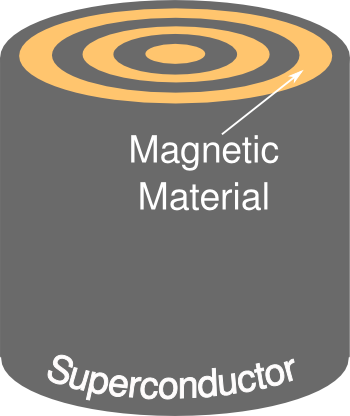
Magnetic hose construction.
The hose is constructed from alternating layers of superconducting and magnetic material around a magnetic core.
(Illustration by the author using Inkscape.)
The demonstration device had an iron alloy core surrounded by the YBCO superconductor, and it was 14
centimeters long.[2-3] This device demonstrated a four-fold improvement of magnetic field transfer than what could be obtained without the superconductor.[2-5]
mathematical modeling shows that many, thin layers will offer a greater transfer
efficiency.[5]
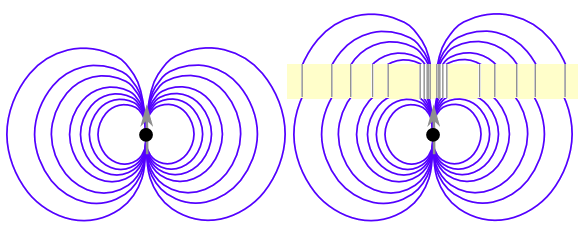
A short magnetic hose, shown in yellow, translates the field of a magnetic dipole. This illustration uses the traditional field line representation of a magnetic field. (Illustration by the author using Inkscape.)
Potential applications for such a magnetic hose exist in such present magnetism-based devices as
superconducting quantum interference device (SQUID)
microscopes and
magnetic resonance imaging devices.[3]
Tapering the hose might also allow concentration of magnetic field strength. Similar
flux concentrators made from the magnetic alloy,
permalloy, are used in magnetic
sensors.[3] Although it's suggested that nothing will limit application of such hoses, even at
nanometer scale,[5] it should be noted that strong magnetic fields will penetrate a superconductor to a
significant depth.
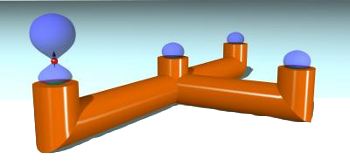
Distributing a magnetic field with a magnetic hose.
(Universitat Autònoma de Barcelona image.)
A good summary of this research was made by lead author, Alvar Sánchez,
"...Until now there was nothing similar [to optical fibers] with which to guide and transport static magnetic fields."[5]
References:
- Joseph Polchinski, "Monopoles, Duality, and String Theory," Dirac Centennial Symposium, Tallahassee, Dec. 6-7, 2002, Posted on arXiv, April 4, 2003.
- C. Navau, J. Prat-Camps, O. Romero-Isart, J. I. Cirac, and A. Sanchez, "Long-Distance Transfer and Routing of Static Magnetic Fields," Phys. Rev. Lett., vol. 112, Document No. 253901 (23 June 23, 2014), DOI: 10.1103/PhysRevLett.112.253901. An open access PDF version is available, here.
- Steven M. Anlage, "Viewpoint: Magnetic Hose Keeps Fields from Spreading," Physics, vol. 7, Article No. 67 (June 23, 2014), DOI: 10.1103/Physics.7.67.
- Creen la primera "fibra magnètica" del món, Universitat Autonoma de Barcelona Press Release (Spanish), June 25, 2014.
- World's first magnetic hose created, Universitat Autonoma de Barcelona Press Release (English), June 25, 2014.
- A. Sanchez, C. Navau, J. Prat-Camps, and D. X. Chen, "Antimagnets: Controlling Magnetic Fields with Superconductor-Metamaterial Hybrids," New J. Phys., vol. 13, Document No. 093034 (September, 2011).
- F. Gömöry, M. Solovyov, J. Souc, C. Navau, J. Prat-Camps, and A. Sanchez, "Experimental Realization of a Magnetic Cloak," Science, vol. 335, no. 6075 (March 22, 2012) pp. 1466ff..
Permanent Link to this article
Linked Keywords: Electricity; magnetism; fundamental interaction; four fundamental forces; electromagnetism; gravitation; strong interaction; strong nuclear force; weak interaction; weak nuclear force; electric dipole; electric field; space; magnetic dipole; magnetic field; analogy; electric charge; ion; electric monopole; magnetic charge; magnetic monopole; physicist; wire; electrical conductor; electrical circuit; magnet; magnetic material; analogy between magnetic circuits and electrical circuits; electromotive force; magnetomotive force; electric current; magnetic flux; electrical resistance; magnetic reluctance; horseshoe magnet; keeper; demagnetization; Wikimedia Commons; vacuum; free space; pedagogy; pedagogical; hydraulic analogy; Oliver Lodge; radio; father; transformer; utility pole; storage container; hose; translation; translate; scientist; Autonomous University of Barcelona; Universitat Autònoma de Barcelona (Barcelona, Spain); Austrian Academy of Sciences (Innsbruck, Austria); University of Innsbruck (Innsbruck, Austria); Max Planck Institute of Quantum Optics; Max-Planck-Institut für Quantenoptik (Garching, Germany); superconductivity; superconducting; superconductor; high temperature superconductor; yttrium barium copper oxide; YBCO; ferromagnetism; ferromagnetic; iron; alloy; Meissner effect; German; Walther Meissner; Robert Ochsenfeld; history of superconductivity; discovery of superconductivity; Heike Kamerlingh Onnes; experiment; cryogenics; cryogenic temperature; Piotr Jaworski; author; Alvar Sánchez; colleague; research; coaxial; cylinder; proof-of-concept; Inkscape; centimeter; mathematical model; efficiency; field line; SQUID; superconducting quantum interference device; microscope; magnetic resonance imaging; cone; taper; flux concentrator; permalloy; sensor; nanometer; London penetration depth; optical fiber.